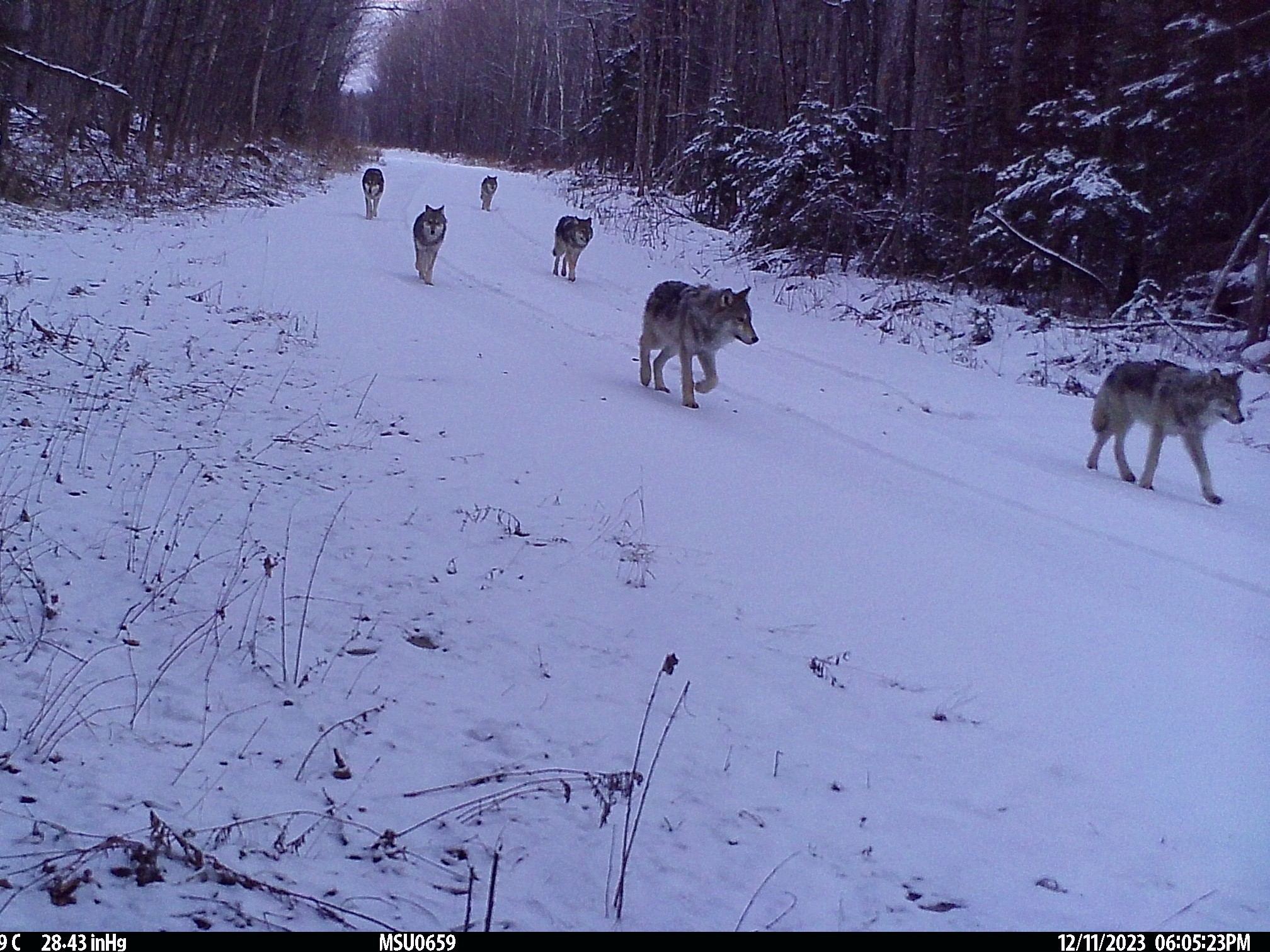DNR Conducting Northern Lower Peninsula Wolf Survey, Seeking Public Reports
Photo: A group of six gray wolves is shown walking down a snow-covered road in the Upper Peninsula. The image was captured on a trail camera image in 2024 as part of the Michigan Department of Natural Resources’ wolf abundance study. Credit: MDNR
The Michigan Department of Natural Resources (DNR) is in the midst of a community-based survey to detect potential gray wolf presence in the northern Lower Peninsula. The survey runs February 17 through March 10 and will rely on public reports of wolf sightings, tracks, and other evidence.
“Our efforts will be concentrated in the northern Lower Peninsula, which has some limited suitable habitat that could potentially support a small wolf population,” said Brian Roell, DNR large carnivore specialist in Marquette.
How to Report a Wolf Sighting
Sightings, photos, and other potential evidence can be reported through the DNR’s Eyes in the Field webpage. Reports, including photos or videos, will be reviewed by DNR Wildlife Division staff, who will provide a response.
“By enlisting help from the public, we can exponentially increase the number of eyes looking for wolves,” Roell said. “With few records of wolves in the northern Lower Peninsula in modern times, efforts to find them will be challenging, and there is a distinct possibility that they are not present at this time.”

Distinguishing Wolves from Coyotes
Properly identifying a wolf is crucial, as coyotes are much more common in the region. The DNR offers the following key differences:
- Size: Gray wolves are significantly larger than coyotes, typically weighing between 50 and 100 pounds, whereas coyotes weigh around 25 to 45 pounds.
- Appearance: Wolves possess broader snouts, blockier heads, and longer legs compared to coyotes, which feature pointed snouts and slimmer bodies.
- Coat Color: Wolves are usually gray, black, or a combination of colors, while coyotes typically display tawny or reddish hues with white or gray underbellies.
- Track Size: A wolf’s paw print is generally more than 4 inches in length, whereas a coyote’s track measures between 2 and 2.5 inches.
Historical and Recent Wolf Sightings
Gray wolves were eradicated from the Lower Peninsula in the early 20th century due to habitat loss, bounties, and persecution. However, they naturally returned to Michigan’s Upper In the early 1990s, the Peninsula saw populations stabilizing in the region. A winter survey for 2023-24 estimated at least 768 wolves in the U.P.
While the Straits of Mackinac pose a significant barrier for wolves moving south, occasional sightings have been documented. Notable cases include:
- 2004: A wolf was accidentally killed in Presque Isle County.
- 2014: A genetic analysis confirmed the presence of a wolf in Emmet County.
- 2024: A hunter in Calhoun County mistakenly harvested a large animal, which was later confirmed to be a gray wolf. The DNR is still investigating how this wolf ended up in southern Michigan.
A similar survey in 2019 resulted in 97 public reports of possible wolf activity, but most were determined to be coyote or dog tracks or could not be verified. However, two credible reports from Kalkaska and Montmorency counties led the DNR to continue monitoring those areas.
Survey Partners and More Information
This year’s wolf survey is being conducted in collaboration with the U.S. Department of Agriculture’s Wildlife Services, the Little Traverse Bay Bands of Odawa Indians, the Grand Traverse Band of Ottawa and Chippewa Indians, and the Little River Band of Ottawa Indians.
For more details on wolves in Michigan and how to participate in the survey, visit Michigan.gov/Wolves.





 8123 Main St Suite 200 Dexter, MI 48130
8123 Main St Suite 200 Dexter, MI 48130


